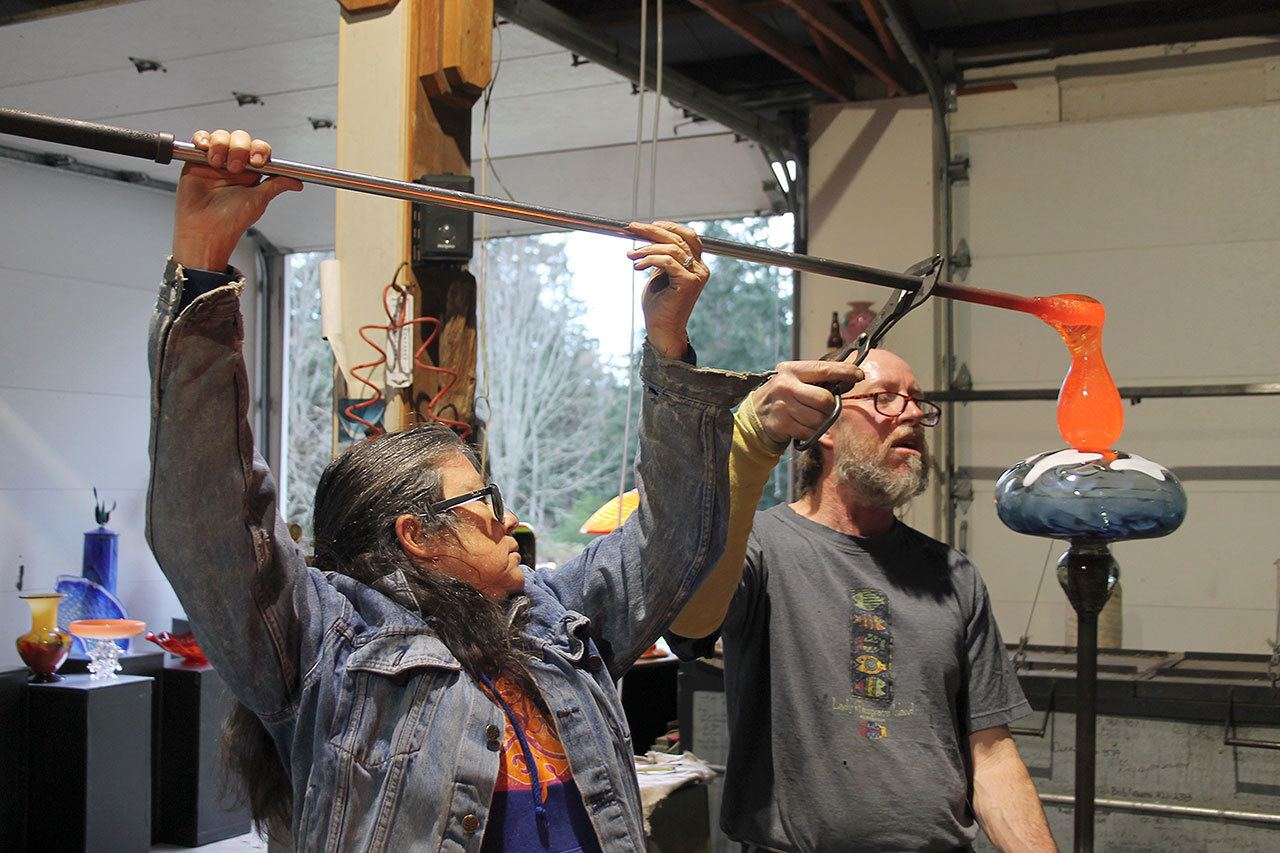Works of art often come from an individual’s imagination, but for some, creating something special is a group effort.
Take Dan and Joi LaChaussee, the artists behind LaChaussee Blown Glass. It’s not just a team effort. It’s a familial thing.
“We’ve been working together since we first met in the ‘80s at the Pratt Fine Arts Center in Seattle,” Joi LaChaussee said. “And when we had kids, I didn’t push them into it, but they still wanted to try it. Now everyone in the family somewhat knows how to do it.”
Inside their Freeland-based hotshop, located across from the Earth Sanctuary on 5555 Emil Road, the LaChaussees can be found working around their melange of glass-blowing equipment — a furnace, a color kiln, which is used for reheating, tables and seats for shaping the piece and an annealer, which slowly cools the glass. The hot shop they built in 1999, which looks like a massive car port or fire station, includes 15 garage doors, a kitchen and an upstairs area to kick their feet up. The studio is part of the Whidbey Art Walk, and their doors are open for visitors whenever the sign is displayed in the property’s driveway. Calling ahead of time at (360) 420-7624 is suggested.
“Somebody once told me we have the Taj Mahal of studios on the island,” Joi LaChaussee said with a chuckle.
Their workflow is like clockwork. They’re both constantly moving and talking throughout the process to make sure they’re on the same page, surprisingly without ruffling each others’ feathers. As they work together to combine colors and shapes for the piece they work on, it’s clear the two have about 30 years of experience in front of the furnace as a team. Upon completing a piece, the two drop the work into an annealer to slowly cool, congratulate each other on their success and wrap it up with a kiss. They won’t see the work for two days while it properly cools, but after all these years they expect a job well done.
“When my wife is happy with the piece, that makes me happy,” Dan LaChaussee said. “We bring different kinds of energy to our work at different times. It works out great.”
Much of the work from LaChaussee Blown Glass is functional art — vases, lamps, jars, bowls and platters. But as artists, they’re always looking to create something a little bit different from previous works. They don’t typically do custom works anymore; as Dan LaChaussee puts it, they focus on “what we want to do, whatever that may be.” When a Record reporter came by their hot shop, that “whatever” happened to be a ocean blue wavy-tipped bowl with orcas that form a circle on the base of the bowl.
“We’re trying to do new things all the time, including this piece right here with the orcas,” Dan LaChaussee said. “We have a lot of repeat costumers. We’re trying not to disappoint their high standards.”
Even when they hang up their glass blowing boots, their customers will continue to have LaChaussee glass pieces to choose from. Their 28-year-old son, Aaron LaChaussee, has inherited the glass artist genes from his parents. His mother says he’s been near the kiln since he was a toddler, and first learned the ways of the hot shop when he was just three years old. Nowadays he can be found shaping glass art at the Schack Art Center in Everett and at his parents’ studio from time to time.
“I’m addicted to glass,” Aaron LaChaussee wrote on his Whidbey Art Gallery biography. “I love it. I love the way it feels, the alluring way it moves, it’s seductive radiance. Glass is my mistress.”
The LaChaussees regularly depart Whidbey, usually during the wintertime, to travel the country to attend various glass art shows. They typically have their eyes set on shows in the Southwest. Dan LaChaussee says the “big ones” they aim for are in Palm Springs, California and Scottsdale, Arizona. But for the next few weeks, they can still be found scrambling in their hot shop on Whidbey as they meld and twist and reconfigure glass into beautiful art works to bring to the winter showcases.
It’s clear the artistic duo have made a living out of their passion. And although Joi LaChaussee says they’ve reached the point where they wouldn’t know what other work they would do, they’re content with that.
“When you think about it, it’s pretty amazing to come from where we were to where we are now,” Joi LaChaussee said. “We spend our days making these beautiful pieces, in this massive hot shop. I don’t think we saw this in the future.”


